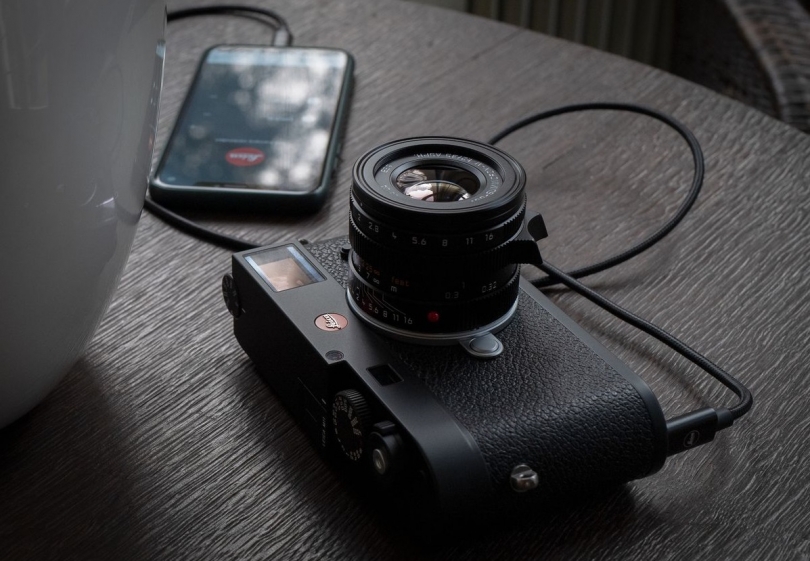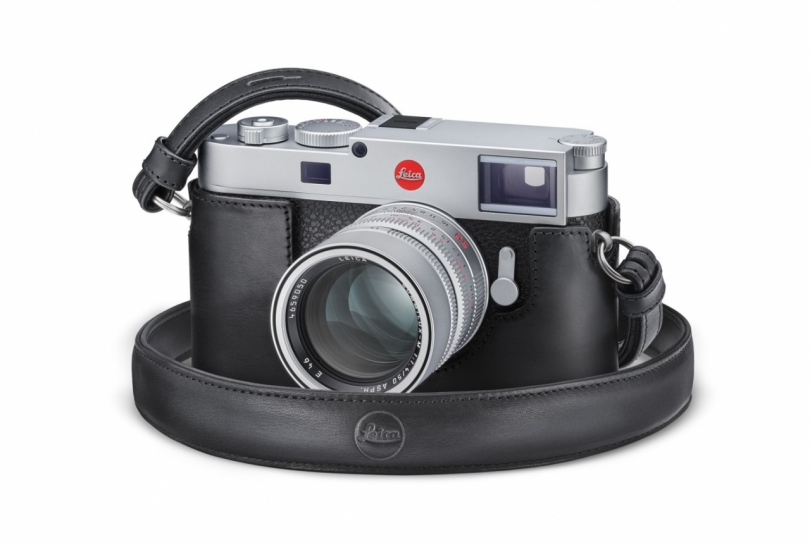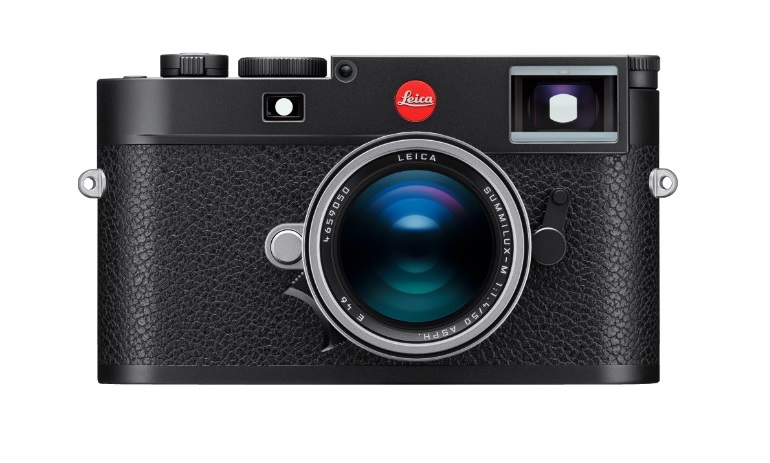
$(document). ready(function() { SampleGalleryStripV2({"galleryId":"2679121576","isMobile":false}) }) All images by DPReview The Leica M11 is a digital rangefinder camera built around a 60MP BSI CMOS sensor.
It's the latest in Leica's 'M' series of rangefinders that dates back to the M3 from 1954. With this unrivaled depth of heritage behind it, it's no surprise that the M11 looks a lot like its predecessors.
Despite the visual similarities, there's a lot that's changed in the latest model, with a more refined body design as well as completely new internals.
Key Specifications
60MP BSI CMOS sensor with dual gain design
Multi-field (matrix) light metering
ISO 64 - 50,000
Three Raw resolution options (60MP, 36MP, 18MP)
SD card accessible from battery compartment (no removable base plate)
64Gb of internal memory
Exposures up to 1 hour, e-shutter down to 1/16,000 sec
Live view stabilization (digital shake correction of preview image)
Compatible with Visoflex II 3. 68M-dot tilting accessory EVF
The M11 will be available in two forms: a classic silver version with black leatherette band around the center and a brass top-plate, and a black version that uses aluminum instead, making it around 100g lighter. The recommended retail price for both colors is $8995.
Jump to:
What's new | How it compares | Body & handling | Initial impressions |
Sample gallery | Specifications
What's new
60MP BSI sensor
The M11 is built around a 60MP BSI CMOS sensor. This is a considerable jump from the 24MP of the M10 and the 40MP of the M10-R. Critically, though, it's also a move to a back-side illuminated pixel structure.
BSI sensors put the light-sensitive part of the pixel closer to the front of the chip. In small chips this has a noise benefit by shifting the wiring out of the way and making a larger proportion of each pixel light-sensitive, but in sensors with relatively large pixels, the greater benefit stem more from the fact that the light-sensitive region is at the very front surface of the chip, rather than being set down into the pixel a little. This is especially important for pixels near the edges and corners of the sensor, where light is likely to approach from increasingly shallow angles, making it difficult to guide the light down into the pixel.
This property is particularly valuable for systems such as the M mount, which has a very short flange-back distance, meaning lenses mount very close to the sensor, and that offers compatibility with lenses that were designed with film, where this wasn't such a concern.
Two-layer filter stack
The M11's sensor also features a very thin, bonded two-layer filter in front of its sensor, rather than the traditional IR filter and protective glass, again prompted by the need to accept light arriving at very shallow angles.
Thick cover glass makes it more likely that these shallow-angle light rays will reflect, rather than passing through the glass to the sensor. Also, the accuracy of the IR filtering is reduced for shallow-angle light, leading to some visible light being lost.
For the M11, Leica has cemented a very thin, very specific IR filter layer to a very thin UV filter layer. It claims that the thinness ensures more light reaches the right pixels, improving corner sharpness, and that the corner pixels experience very precise IR and UV cut-offs, allowing the use of R, G, B filter dyes that capture the full spectrum of visible light, delivering greater color accurately.
The M11's shutter blades are open much of the time, allowing the main image sensor to be used for metering. They quickly swipe across the sensor when exposure is initiated (in mechanical shutter mode, at least).
Multi-field metering
The M11 does all its exposure metering using its main imaging sensor, rather than having a secondary light meter measuring light reflecting off the shutter blades. This allows it to be the first M-series camera to offer 'multi-field' (matrix) scene metering.
Adjustable resolution
The M11 also allows you to shoot both Raw and JPEG files at a choice of three resolutions: 60MP (L), 36MP (M) and 18MP (S). These reduced file sizes are created having initially sampled all the sensor's pixels, which gives them a noise benefit and reduced risk of moire, compared to line-skipping or sub-sampling the sensor in some way.
The noise benefit that comes from downscaling means that Leica quotes the dynamic range of the M and S files as being one stop higher than the 14-stop figure it gives for 60MP mode (the highest of any M to date, the company says). Users can select JPEG and Raw resolutions independently of one another.
We're told the sensor is not Quad Bayer, or some other layout specifically designed for pixel binning.
Cropped modes
The M11 also uses its 60MP resolution to offer two cropped modes: a 39MP mode that gives a 1. 3x crop and an 18MP mode that provides a 1. 8x crop. Unlike the downsized full-sensor modes, these crops apply to both the Raw and JPEG. That said, the crop is only a metadata tag in the Raw file, so can be over-ridden as you edit: the full sensor data is always available.
Live view stabilization
New to the M11 is a stabilized live view magnified mode, which makes it easier to fine-focus close-up subjects. The stabilization is all digital, showing a window of the sensor's view and then moving it to correct for any camera motion. This need to use a cropped-in region means it's only used for the preview: there's no correction applied to the final image.
Return to index
How it compares
There's very little point comparing a Leica M: a manual focus digital rangefinder to anything else, since the only reason to choose one is because you want the Leica name, the rangefinder experience or a combination thereof. However, there are multiple (very similar looking) models in the M range at any given time. The current options include the M1-R and M10-P
Leica M11
Leica M10-R
Leica M10-P
Leica M10
Launch date
Jan 2022
Jul 2020
Aug 2018
Jan 2017
MSRP at launch
$8995
$8300
$7995
$6600
Current list price
$8995
$8995
$7795
$7995
Sensor
60MP BSI CMOS
41 CMOS
24 CMOS
24 CMOS
ISO range
64 - 50,000
100 - 50,000
100 - 50,000
100 - 50,000
Max rate
4. 5 fps
4. 5 fps
5 fps
5 fps
Shutter speed range
3600 - 1/4000
(E-shutter to 1/16000)
960 - 1/4000 sec
8 - 1/4000 sec
8 - 1/4000 sec
Rear LCD
2. 33M dots
1. 04M dots
1. 04M dots
1. 04M dots
Touchscreen
Yes
Yes
Yes
No
Color options
Silver (Brass)
Black (Aluminium)
Silver
Black
Black (no dot)
Silver (no dot)
Black (no dot)
Silver
Black
Top-plate script?
No
Yes (black paint / no dot verion)
Yes
No
In addition to these four models there's also the M Monochrom, a variant of the M10-R with no color filter array in front of its sensor, giving it a base ISO of 160.
What's noticeable is the degree to which the launch prices for each model has crept up relative to preceding one, and the fact that the list prices have also been raised since each was launched. Leica said part of this was a result of the strength of the US dollar, relative to the Euro, but with luxury goods, exclusivity is part of the marketing proposition. The M11 launches for the same price as the M10-R, but offers more in every respect.
Return to index
Body and handling
There's no mistaking the M11 for anything but a Leica rangefinder. Chances are you'll need to directly see one alongside the M10 to be able to work out which is which. Despite this, there have been major changes.
The biggest is that the M11 adopts the directly accessible battery design from the Leica Q and SL models. There's no battery door: instead a base plate on the battery forms part of the camera's outer surface. The battery is released by flicking a small lever on the base of the camera, letting it start to slide out of camera body, a small upward push is then needed to release a second catch that stops it just falling directly onto the floor.
Removing the battery provides access to the SD card slot that sits inside the same compartment.
There's no removable base-place anymore, with a latch lever to release the battery and reveal the SD card slot. Note the exposed USB-C socket to the left of the battery bay.
This change means there's no longer a base plate that needs to be unscrewed to access the battery and cart slot. Yet, ironically perhaps, the need to do so has been radically reduced on the M11, thanks to the provision of a USB-C connector on the base of the camera.
This USB-C socket can be used for charging the camera and for rapid offload of data, from a memory card or the 64Gb of internal storage built into the camera. The camera comes with an Apple certified USB-C to Lightning lead for connection to iPhones and iPads.
There have been other subtle changes, though. The M11 regains a function button on its top plate, next to the shutter button (as was the case with M Typ 240). This, along with the Fn button on the back of the camera and pressing the rear command dial inward, makes it three customizable control points. In all three instances, a long press of the button brings up the menu to re-configure which function is assigned, making it simple to configure the camera to your needs.
The camera's rear screen also gets an upgrade, with a panel made up of 2. 33M dots (1080 x 720 pixels), up from 1. 04M dots on the M10 models.
The M11 also gains a new battery: the BP-SCL7. It's a 13. 3Wh battery, which represents a 64% increase in capacity compared with the SCL5 used in the M10 models. This is enough to power the M11 to a battery rating of 700 shots per charge, when tested using CIPA standard tests. As always we find these numbers are usually comparable between cameras but tend to under-represent how many shots you're likely to get. A rating of 700 shots (presumably using the optical finder) is very good. It's not uncommon for us to get twice as many shots out of the battery as the CIPA rated number, and Leica says it can get 1700 shots using its own shooting cycle.
Return to index
Initial impressions
By Barnaby Britton
The Leica M11 is a curious machine, designed in the 21st Century, but in large part developed midway through the 20th. The M11 isn't unique in spanning such different technological eras of course – every M-series rangefinder since (arguably) the M7 has served to some degree as 'fan service' for photographers who simply enjoy shooting with them, in preference to countless more affordable, more technologically advanced and in some respects more capable alternatives.
The M11 is Leica's surest step yet in the direction of truly modernizing the M-series, but I don't know if I'm complete sold. I will say though that the new sensor is fantastic, and offers a lot more resolution, and better image quality than was possible from the M10 – the last digital M-series I used extensively. Auto exposure is generally a little less unpredictable too, thanks to the fact that the M11's sensor is 'always on', and capable of multi-mode metering. But that extra resolution brings up a longstanding issue with the digital M-series: there is a limit to the accuracy you can hope to achieve with a mechanically coupled rangefinder focusing mechanism, and the more pixels you put behind the lens, the more obvious this becomes. Ditto optical issues with older lenses, which were invisible on film, perhaps acceptable at 18-24MP, but become obvious at 60MP. Yes, you can always downsize images from the M11, but I suspect that most photographers won't feel great about throwing away so much resolution.
The Leica M11's rangefinder focusing mechanism is great for focusing in low light - especially if your subject features lots of vertical lines.
Leica M-Summilux 35mm F1. 4 ASPH @F1. 4 | 1/125sec | ISO 2,500
When I first heard that the M11 would effectively operate in live view mode all the time, even if the LCD/EVF were turned off, I had hoped that this meant Leica had added phase-detection pixels to the central zone, represented by the rangefinder patch. This might have allowed for electronic focus confirmation with the optical finder. That, to me, would have been the perfect melding of a classic mode of operation with modern technology, and would have helped mitigate the issue of critical focus on such a high-resolution sensor. Sadly though this either wasn't possible, or wasn't deemed desirable by Leica's engineers.
I'm glad that Leica has opted to start blurring the line between analog and digital shooting experience a little more confidently
Unfortunately, along with (but possibly unrelated to - this is something we want to dig into) the M11's 'always on' sensor comes a pretty lengthy startup time. The M11 takes around two seconds to power up, before you can take a picture. That's about on a par with the film-era M7 (in AE mode): a startup delay which at the time it was launched caused a degree of outrage of the 'it's not a real Leica!' variety.
Another small niggle is the M11's shutter sound. Several Leica M10 variants featured a redesigned, notably quiet shutter mechanism which I had assumed would be adopted in the M11. Not so. The M11's shutter sounds to my ear exactly like a stock M10. It's a small thing, and of course new in the M11 is a fully silent electronic shutter option, so whether this bothers you or not will probably come down to personal preference (do I have a thing about shutter sounds? Maybe I do. . . ). The fact that even with a newly designed baseplate you still can't swap out the M11's battery or memory card with a standard tripod plate attached is frustrating, but I accept that this is likely to be a niche use-case (and you can at least use the offset USB-C port to power the camera or offload images).
At wide apertures, especially on 50mm and longer lenses, precise focus can be tricky, particularly if your subject is not positioned in the dead center of the scene. For this shot, I used the M11's magnified manual focus live view to make sure that the stars on the flag were sharp.
Leica M-Summilux 50mm F1. 4 ASPH @F2. 8 | 1/250sec | ISO 64
If I sound over-critical, that's because a) This is a $9,000 camera, and photographers should expect a lot for that kind of money, and b) I'm emotionally invested – I happen love the rangefinder shooting experience, and over the years I've owned or at least used almost every single model in Leica's M-series. A new digital M is always exciting to me – something to look forward to. Ultimately, the M11 is a lot of fun to shoot with, and gives great results, once you've learned your way around its quirks – some long-standing, some inherent in the design, and some new. It is by far the most versatile and capable member of the M family yet, and I'm glad that Leica has opted to start blurring the line between analog and digital shooting experience a little more confidently than in previous generations.
Return to index
Sample Gallery
Please do not reproduce any of these images on a website or any newsletter/magazine without prior permission (see our copyright page). We make the originals available for private users to download to their own machines for personal examination or printing (in conjunction with this review). Please refrain from using them for any commercial purposes.
Images shot using a Pre-Production Leica M11
$(document). ready(function() { SampleGalleryV2({"containerId":"embeddedSampleGallery_5740841570","galleryId":"5740841570","isEmbeddedWidget":true,"selectedImageIndex":0,"isMobile":false}) });
Return to index
. dpreview.com2022-1-14 17:00





